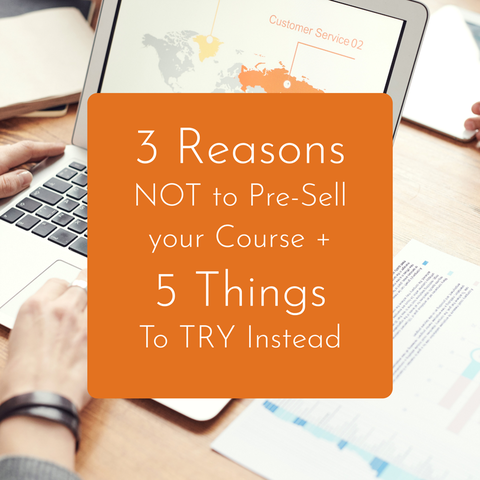I get it, creating a course is a huge investment, in time, and often in money as well.
You need to create the content, record the videos, do the tech, buy the software and plugins, and maybe hire someone to help.
It’s a big undertaking.
BUT
Oh yes, the all-important but…
If this is your first course, do not pre-sell.
3 Reasons Not to Pre-Sell your Course
You don’t know how long it will take you to create the content
In a perfect world, you might be able to smash it out quickly, but if this is your first course, you can’t preempt the things which might end up taking you longer than you thought. Tech issues, integration issues, issues with content creation or videos (hopefully it will all go swimmingly, but usually there is a stumbling block at least once along the way) If you pre-sell with a promise to launch in 4 weeks, you can’t guarantee that you can get it ready in that time frame.
It puts a lot of stress on you
Content created under stress isn’t your best work. I’m all for deadlines, they help me stay on track, but the stress of trying to smash out something which is pre-paid doesn’t allow me to focus on making the most engaging and useful course that I can.
It can create a poor user experience
Having a big lag time between purchase and start date gives your audience time to get cold feet about their purchase. You need to focus on providing value and great user experience during this time, which is hard to do if you are busy creating content still.
I get it though, you want to know that it’s worth it, so what can you do instead of pre-selling?
Here are 5 Things you Can Do Instead
Validate your idea
Before you jump in headfirst and create your thing, make sure there is a market for it. Interview your ideal clients, have a chat about where they are stuck and what they need help with. Your course might seem like a good idea, but if you’ve built an audience by being a web designer, it’s possible that your audience doesn’t want to learn how to build their own site because they want you to do it for them. (This doesn’t mean you can’t create one, but you will need to build a new audience for it.)
Test free launch content
Want to know if there is a market for your course? Create a piece of free launch content directly relating to the course outcome you want to deliver. If you get good list growth and start to build a solid audience around this piece of content, then it’s a good sign for your course
Start with a smaller course
Rather than jumping in at the deep end and creating an 8 week, or 12 weeks, signature program, start with something small. It might be a 3 module, outcome specific mini-course. Or a paid challenge which drip feeds content over 5 days, 10 days or even a month. By creating these smaller pieces, it gives you an opportunity to get into the swing of creating content and getting all the tech pieces working, without spending months building something huge. These still give you an opportunity to make a good return and test the market for your bigger program.
Collaborate
Rather than building your first course from scratch, maybe look working with a group of businesses with a similar audience, and all build a module each. This gives you an opportunity to test the platform, just focus on building one module of content and have an opportunity to reach a larger audience.
Build module 1 first.
If you are convinced that you want to pre-sell, then start by creating all of your welcome content and module 1. This way you have an estimate of how long it took you to create the content, and do the tech and upload. Once those first segments are working well, you can start to sell the course, and you have a little leeway to create module 2 onward. if you found it took you 6 weeks to create module 1, then it’s probably not sustainable to try and pre-sell the course and create the next 5 modules in a rush to deliver.



Completely agree, Sam.
From a user experience, when I complete a module that clearly hasn’t been tested, has spelling or formatting errors, I am unlikely to purchase again. Regardless of price – free or high end. The user experience is king.
This issue I believe stems from – lots of marketing of creating eLearning as the path to financial freedom. Whilst it can be, it is exception to the rule.
My advice to anyone starting on this path, is to engage instructional designers and eLearning experts to assist in ensuring that adult learning principles are met, and the learner needs are met.
I think you’ve hit the nail on the head Colleen, it’s sold as the path to financial freedom.
When the truth is there is often an upfront investment (time and or money) to get your course written and online.